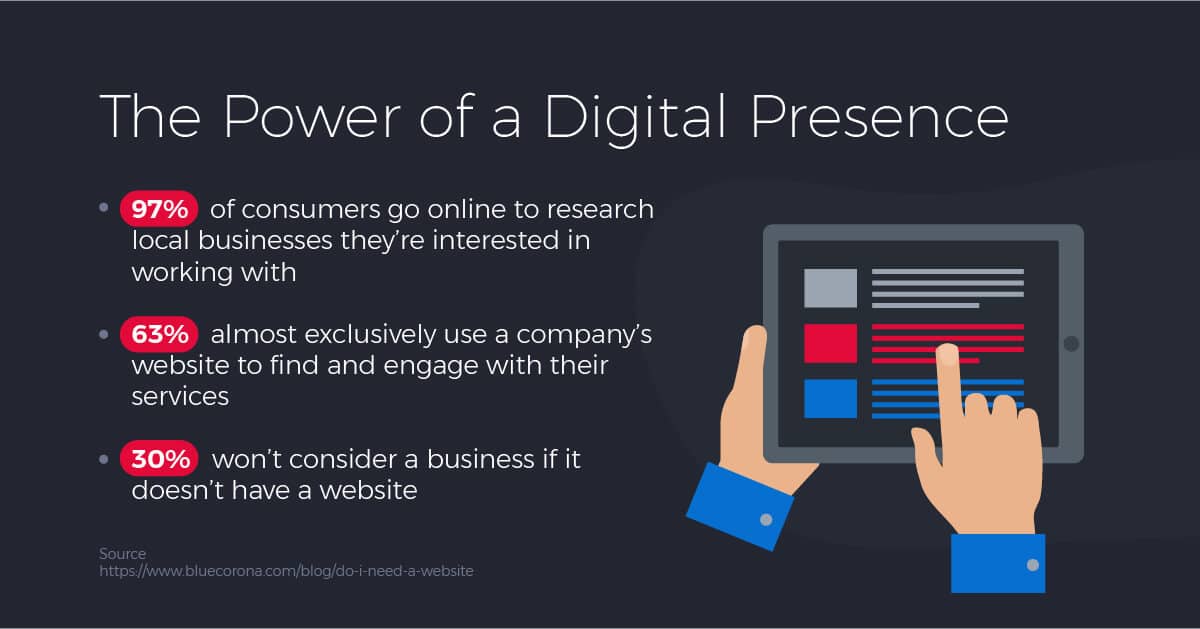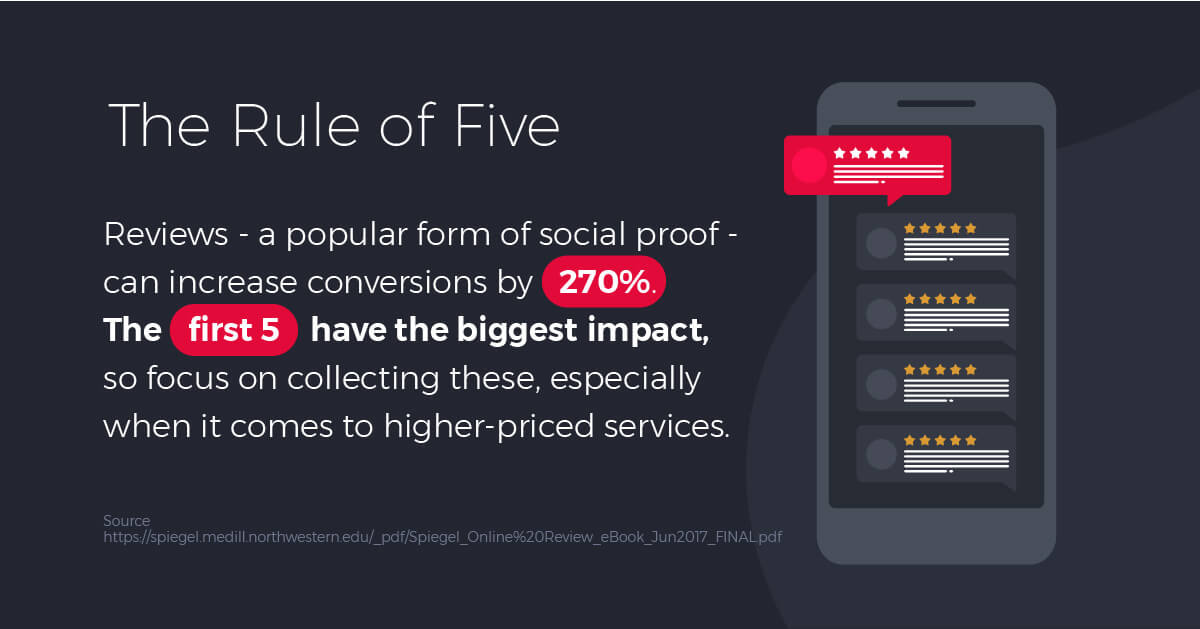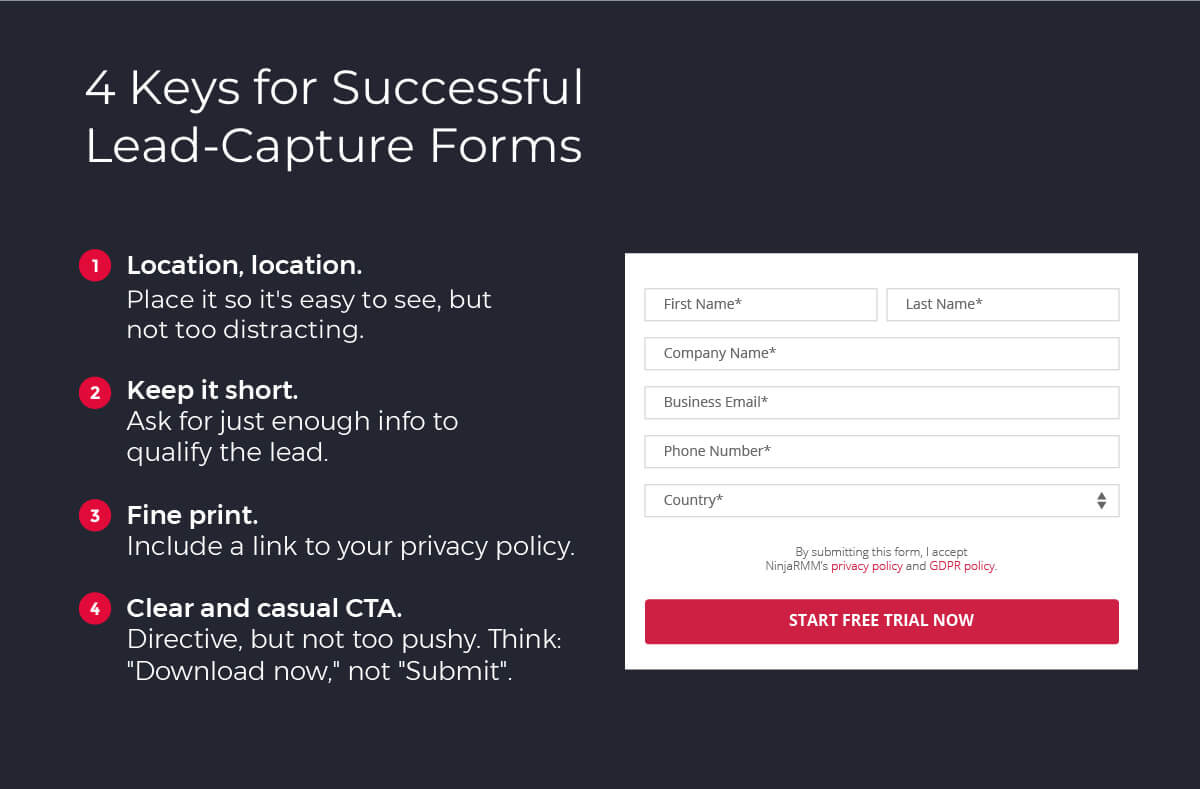Is your website generating new leads for your MSP business? If not, it may be time for an update. This guide shares all the tips and tools you’ll need to maximize MSP lead generation using effective MSP website design.
What’s the first thing a customer sees when they use a search engine to look up your MSP business?
Is it your personal LinkedIn profile? Ok, not bad.
Is it a bunch of blurry social media pictures from your whale-watching vacation seven years ago? Not great. ♂️
Or, is it a modern, easy-to-navigate website that tells them everything they need to know about your MSP services? Your business expertise. Your happy customers. How they can get in touch to become a happy customer themselves.
We have a winner! That’s the result you want.
Why? Because over 80 percent of consumers perform online research before committing to a purchase. The majority of them are going to have a hard time choosing you over your competition if you don’t have a web presence OR the presence you do have doesn’t inspire confidence.

Source: Blue Corona
Don’t you want to control the narrative about your business, create a showcase of your most awesome work, beat your competition to the punch, and be available (without, you know, actually being available) around the clock for potential consumers?
If so, it’s time for you to create or upgrade your MSP website to get more visitors, more leads, and more money in your pocket.
Whether you already have an MSP website and marketing plan or you’re starting from scratch; this guide will help you crawl, then walk, then run from a foundation of quality content and design to smart investments in digital marketing and lead generation technology.
Beginner
Get Your Crawl on with an Easy, Customizable MSP Website Builder
There has truly never been an easier or more cost-effective time to launch a website.
Whereas in the pretty recent past you would have had to register a domain with one service, select hosting from another service, and then build and launch your website using a third service—today you can bundle everything with a single provider and get started with the click of a button.
Most MSPs who are launching their marketing website — that is, a website that’s primarily for hosting your marketing messaging — for the first time can get by with one of these bundled offerings for a decent price from folks like Wix, Squarespace, or even Google. There are plenty of these types of software services out there, but it’s well worth it to do a little research to make sure you’re partnering with a reputable provider.
Earlier this year, the domain registrar AlpNames was terminated by the Internet Corporation for Assigned Names and Numbers (ICANN), leaving the owners of hundreds of thousands of domains scrambling to find new registration — often at a higher cost.
4 Must-Have Elements of a Basic MSP Website
Once you’ve locked in your service provider(s) and are ready to start building your marketing site, be sure to include these key elements to maximize effectiveness:
1) Your Contact Information
If one of the main goals of your website is to turn visitors into leads, you’re going to want to make it exceedingly easy for those visitors to get in touch with you.
You can do this by displaying contact information including your phone numbers(s), email address(es), and even your physical office address prominently on your website.
If you’re worried about making that information public or would like a more streamlined way to organize your website leads, install a contact/inquiry form — most all-in-one website builders will come with this capability.
2) Your Services
You want site visitors to know you are the best MSP for the job.
Make the decision easy for them to by detailing exactly what types of solutions you offer, what kinds of payment plans you provide, and answers to your most frequently asked questions.
This is also a good time to highlight your areas of expertise and show off your credentials so people can see why you’re a good fit for their business.
3) High-Quality Images
A lot of MSP websites end up looking the same. If you’re not ready to spend money on a professional photographer, then set your site apart and convey your attention to detail with creative, fresh, and high-quality stock photos like the ones you’ll find at Pexels, Unsplash, and Stocksnap.io.
4) Social Proof
Social proof is the term for the human instinct to view certain behaviors as “more correct” the more we see other people doing it.
Tap into this instinct by showing site visitors some of the customers you’ve worked with and successful contracts you’ve completed in the past. Case studies, testimonials/reviews, and customer quotes are an easy-to-create and easy-to-display way to provide social proof.
If you’re just getting started and don’t have much to show off yet, highlight the types of companies you want to work with and really play up whatever experience and qualifications you do have.

Source: Spiegel Research Center
While you’re building out all of this website content, it can be easy to go overboard. However, any modern marketer will tell you that readers value messaging that’s clear, correct, and honest.
If in doubt, try Hemingway to see where you can simplify your writing and Grammarly to double-check your spelling and grammar.
We’ll get into all kinds of marketing tricks later, but for now, let’s just make sure prospects and customers can find your new website. Create a free “Business Profile” with Google and give yourself a leg up against the competition when someone uses Google Search or Maps to find a business that provides your services in your area.
Already sound like a lot to handle? For the MSP who doesn’t feel like doing it all themselves, Pronto and JoomConnect offer everything from fully managed websites to blog-writing services that are laser-focused on managed service providers. If you’re dreaming of customizable add-ons or smart features like chatbots (which we’ll discuss more later!), one of our favorite website service providers for that is SiteSpot.
Intermediate
Waltz Through Marketing and Technology Website Upgrades
In our opinion, you don’t really need to build a bigger, more robust website — unless you plan to invest in digital marketing initiatives.
If you’re getting all the leads and customers you need from referrals, attending local events, or posting on social media; your out-of-the-box marketing site should suffice.
However, if you want to explore ways to grow your MSP business using digital marketing — such as paid advertising, search engine optimization, etc. — then follow these next few steps to progress from a crawl to a walk.
Step 1: Develop a Marketing Plan
Some of the digital marketing initiatives you choose to pursue will have an impact on your website design and development plans (or redesign and redevelopment plans), so it’s important to have a marketing plan in place before diving straight into the technology.
If you’re interested in using Google AdWords to advertise your MSP business, all you have to do is make sure that your website really delivers on the promises you make in your ads. You don’t necessarily have to create a whole new, custom-built website to do this — you just need to make sure you follow the tips above to create website pages that are informative while remaining accurate and easy to digest.
However, if you want to go the “organic” route and show up at the top of Google’s results when someone searches for the services you offer without purchasing ads, it’s a slightly different story.
If the website template you’re using is already equipped with a blog section, now’s the time to use it. The best way to become a “thought leader” or “subject matter expert” in the eyes of both Google and potential customers is to publish well-written content around a handful of phrases (aka “keywords”) that relate to your business, your industry, and the problems you solve for your customers.
This list of free keyword research tools from Ahrefs can help you narrow down which phrases you should target in your content.
You may also choose to invest in designing and developing landing pages with the singular purpose of converting readers into leads using persuasive language and lead-capture forms (that meet data privacy regulations, of course).
Another way to woo potential clients is with “gated” content, which typically consists of high-value resources like ebooks and white papers that interested parties have to share their contact information in order to access. This marketing strategy would require you to develop the content, create a landing page to advertise the content and build a mechanism to release the content once you’ve received the lead’s information.
These marketing strategies are likely going to require you to step up your game when it comes to your out-of-the-box website builder — so here’s exactly how to do just that.
Step 2: Upgrade Your Technology Stack
With your marketing plan in place, it’s time to build out a tech stack that supports your initiatives.
If you’re pursuing landing pages, gated content, or a prolific blog; it’s likely you’ll want to upgrade to a content management system (CMS) from which you can create robust content and integrate with key tools to boost your marketing efforts.
If you’re new to CMS, WordPress or Webflow are a great place to start because it’s both easy to learn and easy to build upon as you add those integrations we just mentioned.
With your CMS set up, it’s probably a good time to implement analytics software to monitor how key pieces of content, as well as your website as a whole, are performing.
Google Analytics is a classic for budding brands and established enterprises alike, so we recommend starting there before branching out to see if there’s a better solution for your specific needs.
If you feel comfortable with where you’re at thus far, you may even want to add email marketing to your tech stack so you can more easily stay in touch with customers and stay top of mind with leads.
Chances are you’ve heard of Mailchimp, which is a great tool that goes well beyond just email marketing, but nowadays there are probably hundreds of platforms that make email marketing a snap. This list has several options that even integrate seamlessly with WordPress.
Before we move on, there’s one last element to consider now that your marketing plan is up and walking — do you have the time and expertise to provide the nourishment it needs to be successful?
There’s no shame in admitting that you may need a little help in this department. At NinjaOne, we’re big proponents of finding and following your passion — our goal is to help MSP business owners spend more time working on their business than in their business, after all.
If you do decide to look for marketing content, design, and development support; there are all kinds of platforms like 99designs and Upwork for connecting with freelancers. And of course, there’s the more traditional (but often pricier!) marketing agency route, many of which are just a quick Google search away. For an agency that handles digital and traditional marketing for MSPs specifically, be sure to check out Ulistic.
Now, are we ready to crank up the sophistication when it comes to generating more visitors and leads with your MSP website? Then don’t walk — run to the next section of this article.
Advanced
Run Toward More Visitors, Leads, and Revenue with Analysis and Optimization
If you’ve got your marketing elements running smoothly (i.e. active advertising campaigns, landing pages, and maybe even a small marketing team!) and are pulling in qualified traffic that is converting into sales, it’s time to hit the ground running to leverage that strong foundation.
To ensure you’re making the most of all the time and money you’ve put into your marketing stack, at this stage you will want to build an analyze, optimize, repeat process to ensure you’re always generating the best ROI possible.
Start by analyzing traffic by marketing channel, revenue by the same marketing channels, and lead generation and loss at every stage in your sales funnel.
The sales funnel is simply the path leads travel along on their way to becoming a customer. Integrate a customer relationship management (CRM) platform into any lead-generation tools (forms, email newsletter signups, etc.) on your website to monitor how leads move through this funnel.
The analyses you’ll generate with your CRM (Zoho and HubSpot are both free to sign up) will help you decide where to focus your efforts to optimize marketing and channel performance.
Optimization tactics will differ by marketing channel, so we recommend starting with the one you have the most control over — your website (and here’s how).
Split or “A/B test” each and every tweak that you try so you can measure how they impact conversions. Plug Google Optimize into your website Google Analytics account or try a tool like Optimizely to create experiments and eliminate guesswork when it comes to what works.
Finally, at this mature stage of your MSP website, you may even want to invest in installing new technologies like a chatbot from Drift or Intercom.
If handled correctly, your busy customers, as well as your lead-generation efforts, will thank you for it.
Whether you’re developing and designing your MSP website at a crawl or doin’ the running man toward the cutting-edge marketing tools of the day, the best way to get more visitors and leads is to spend more time working on your business instead of in your business.
Try NinjaOne for free and see why our efficient, modern IT and network management software was voted the number-one RMM on G2 Crowd.








